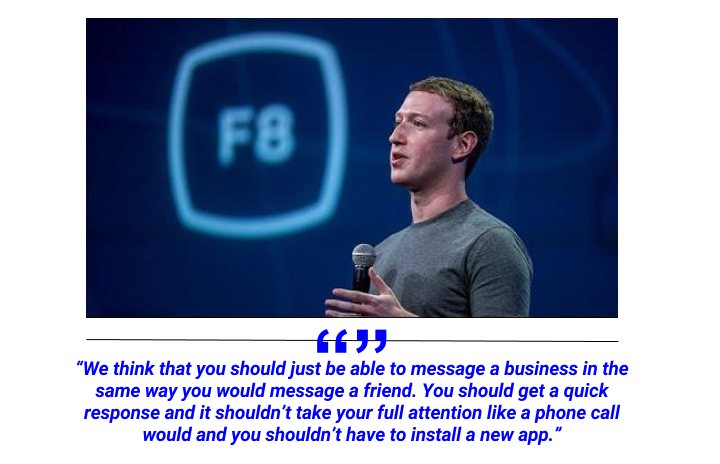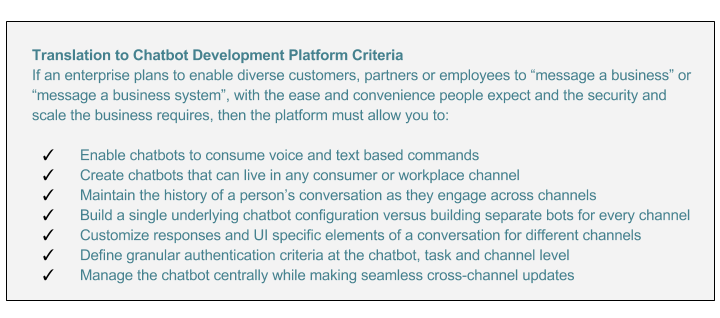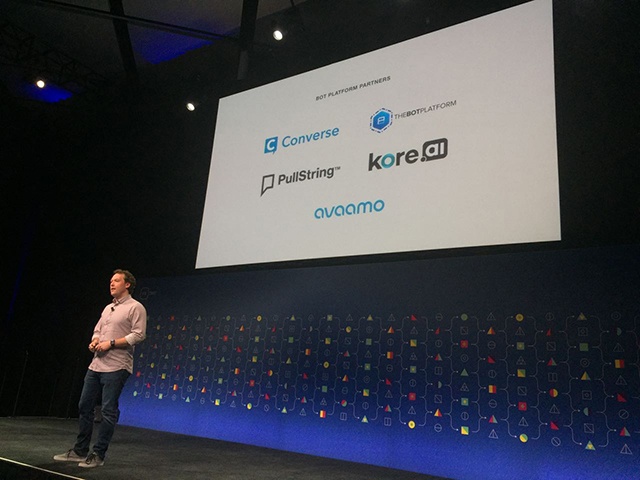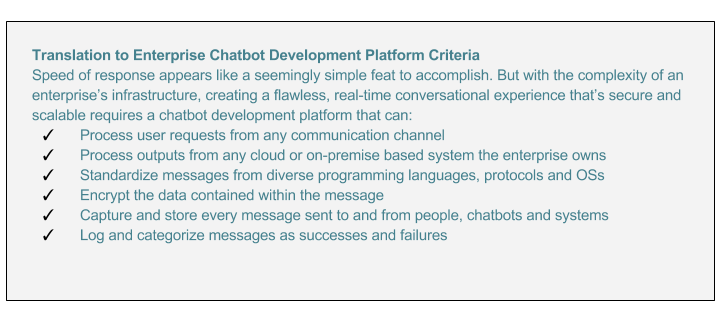It’s no surprise this theme didn’t capture journalist attention. Scalability doesn’t make for a great headline, especially when you stack it against announcements on topics like augmented and virtual reality, artificial intelligence (AI), and Facebook’s continued concentration on chatbots - now both for Messenger and its Slack competitor, Workplace.
But for big enterprises (like your bank, your health insurance provider, your car-maker, and so many others), and the type of companies Facebook envisions leveraging chatbots and AI in both Messenger and Workplace, “scalability” is the “go” or “no--go” factor. Looking at a simple Wikipedia definition of “scalability”, it’s easy to understand why it matters so deeply.

Banks like Citi, JP Morgan Chase, Bank of America, Wells Fargo and their peers serve 50 to 200 million customers, and employ hundreds of thousands in their workforces. Major insurance companies like AXA, State Farm, Liberty Mutual, Allstate and UnitedHealthcare, large automotive makers like Volkswagen Group, Toyota and GM, global conglomerates and manufacturers like Siemens and GE, massive retailers like Costco and Walmart and others, all serve customers and employ people at similar levels of scale. We’re talking about the whales here, and whales gotta scale.
Large companies need confidence that AI-powered chatbots can become a trusted and increasingly autonomous extension of their brand, and knowledge of how customers, employees and partners will interact with them. Knowing if these technologies are “suitably efficient and practical when applied to large situations” is simply a must-have.
Industry observers might already have the impression that chatbots are built at scale today. Facebook reports 100,000 bots available for use in Messenger. But Facebook execs themselves haven’t challenged questions about current chatbot usability and value, including reports stating that 70 percent of chatbots on Facebook Messenger failed to fulfill user requests. And, if you dig under the covers of a vision presented at F8, you’ll find real lessons gained from these experiences about how to evaluate and select a platform on which to build AI-rich chatbots - at enterprise scale.
Also Read: Conversational AI Poised to Take Off as Customer Adoption Rises Across Industries |
Translating a Visionary Statement into Chatbot Development Platform Criteria

Businesses love Mark Zuckerburg’s lofty vision. It has great implications for customer engagement and business efficiency. In fact, many businesses believe this vision can extend beyond their customers. They think partners and their workforce should be able to message the business and its business systems - just like they message a friend.
Employees are tired of using so many complex and cumbersome enterprise apps - an app to book travel and create expense reports, an app to log vacation or project time, an app for sales lead and opportunity management. They’re too busy to search through vast information buried in a company portal or corporate knowledge base just to get simple answers to questions like, “what is the corporate expense policy?” or “how do I take my annual compliance training?” or “what is our Boston office address?”. And, these same employees would be thrilled if the company offered a convenient, true self-service alternative to calling the IT help desk with basic issues like “I need to reset a password,” especially if the system could be intelligent enough to automatically transfer them to a human if an issue became unresolvable or it sensed employee frustration.
While it’s easy for businesses to agree and build upon Mark’s vision, it’s a whole different story to execute on that vision at enterprise scale. That’s why we uncovered the real implications and how they translate to the selection criteria for chatbot development platforms.
“Message a business”
Consider two components of how we as consumers or employees would expect to “message a business” or “message a business system”:
- People expect choice in whether to speak and/or text their messages. Some prefer speech-to-text, others like to type, and others use a combination of the two.
- Individuals prefer and use various messaging “tools” or channels. Some people naturally prefer apps like Messenger, while others favor SMS, e-mail, or even social media channels like Twitter. But if you’re already be on a brand’s website or mobile app, you might actually prefer to “message a business” right there. If you extend that idea of “messaging a business” into “messaging a business system” the preferred channels expand even more. If I’m interacting with a colleague in my company-sanctioned messaging tool, such as Cisco Spark or Workplace by Facebook, and need to approve an employee’s vacation request, that’s the best tool at that moment. But in other scenarios, the channel of preference might be a company portal or mobile app, SMS, or a different tool like Skype, Slack or Microsoft Teams.
Ultimately, how we each prefer to message in our personal or professional lives will vary not just by individual preferences, but also based on the scenario at hand. What are we trying to get done? How long is the message we need to send? Where do we happen to be both physically and digitally at that given moment?

Also Read: How to Select a Chatbot Development Platform: The Underlying Lessons of Facebook’s F8 |
“In the same way you would message a friend”
Next, take into account two very complex elements of what it means to message a business or a business system in the “same way” as a friend.
- People message friends or colleagues in varied ways, or “natural language.”. When messaging with friends, people tend to use a combination of slang, shorthand , work-related acronyms and system-specific language. Some people also message in long form sentences, and use images to convey points.
- We expect human intellect to be applied in conversations with other people. Human dialogue involves context. In order to keep a conversation from being laborious and maddening, you expect friends to understand your individual preferences or background, the subject at hand, and even subjects you’ve previously discussed. You expect them to sense emotions, even in a text, and to know if and when the communication should transition from a text to a call. As importantly, good friends remember and learn from conversations - both good and bad. Or at least the empathetic ones do.
“Get a quick response”
After the 2016 introduction of chatbots, Facebook and the rest of the world quickly learned that people would never engage these digital assistants if the chatbot’s response to a human’s request was “I’ll get back to you in 45 minutes”.
In most cases, people will only choose to message a business or a business system if they can get something done faster than waiting on a call, searching through a website or using an existing app.
Also Read: What Makes a Chatbots Platform Truly Enterprise-class |
Practical Questions to Ask A Chatbot Development Partner
With the excitement of the 2017 F8 conference behind us, here’s some advice to any large business that’s serious about leveraging AI-powered chatbots at scale - for your customers and/or employees: Leave no stone unturned when evaluating the platform to use. Facebook didn’t.

We believe that’s why they selected Kore.ai as a chatbot development partner.
Businesses that choose Kore.ai’s Platform do so because they plan to scale with AI-rich chatbots - to hundreds of thousands of customers and employees, for use cases that require integration to diverse enterprise systems, and to channels that include Workplace, Messenger and so many more. Yet we encourage enterprises to ask Kore.ai and our competitors tough questions to discern whether the platform truly supports the criteria mentioned above and more:
- Do you offer options for the platform to run on-prem as well as in the cloud?
- What kind of tasks can chatbots built on this platform perform?
- Do you offer pre-built chatbots from which a customer can build?
- Do you offer pre-built bots for enterprise systems like SAP, ServiceNow or Salesforce?
- Can chatbots developed on your platform handle complex workflows or dialogs?
- Can chatbots handle requests with multiple intents?
- How does omni-channel bot development work?
- Is the NLP Technology proprietary or of another vendor?
- Can chatbots connect to systems that sit behind my firewall?
- What types of encryption and authentication are supported?
- How are chatbots deployed and updated on the platform?
- Can you sync with Active Directory for employee chatbots?
Because if enterprises really value scalability, they should choose a platform partner that does, too.
Learn more about the Kore.ai Bots Platform and Facebook’s integration partnership with Kore.ai, and access our CIO How-To Kit for real-world guidance and templates that help you create a chatbot strategy that’s scales with your enterprise.













